Let's talk Salukis
Like supermodels floating effortlessly down the runway, Salukis glide around the dog park or anywhere else they have the chance to zip around, light on their feet. Yes, watching the Saluki run is to see grace in motion. The very definition of elegance with their long narrow muzzles and wispy, silky long ears, the Saluki is one of the most ancient hound breeds, nicknamed the “Greyhound of the Desert”—there is a resemblance, though the Saluki is taller and stronger. While wary of new people, once trained, they are wonderful, tolerant and affectionate family dogs, though they’ll prefer to sit at your side, not in your lap.
Official name: Saluki
Other names: Persian Greyhounds, Gazelle Hound, Arabian Hound
Origins: Middle East
Drooling tendencies
1 out of 5Shedding Level
2 out of 5Energy level*
5 out of 5Compatibility with other pets
3 out of 5Warm weather?
4 out of 5Suited to apartment living
2 out of 5Family pet?*
5 out of 5Can stay alone
1 out of 5
| Male | Female |
|---|---|
| Height | Height |
| 59 - 71 cm | 18 - 23 cm |
| Weight | Weight |
| 18 - 29 kg | 18 - 29 kg |
| Life stages | |
|---|---|
| Adult | |
| 1 to 7 years | |
| Mature | Senior |
| 7 to 10 years | From 10 years |
| Baby | |
| Birth to 2 months | |
Drooling tendencies
1 out of 5Shedding Level
2 out of 5Energy level*
5 out of 5Compatibility with other pets
3 out of 5Warm weather?
4 out of 5Suited to apartment living
2 out of 5Family pet?*
5 out of 5Can stay alone
1 out of 5
| Male | Female |
|---|---|
| Height | Height |
| 59 - 71 cm | 18 - 23 cm |
| Weight | Weight |
| 18 - 29 kg | 18 - 29 kg |
| Life stages | |
|---|---|
| Adult | |
| 1 to 7 years | |
| Mature | Senior |
| 7 to 10 years | From 10 years |
| Baby | |
| Birth to 2 months | |
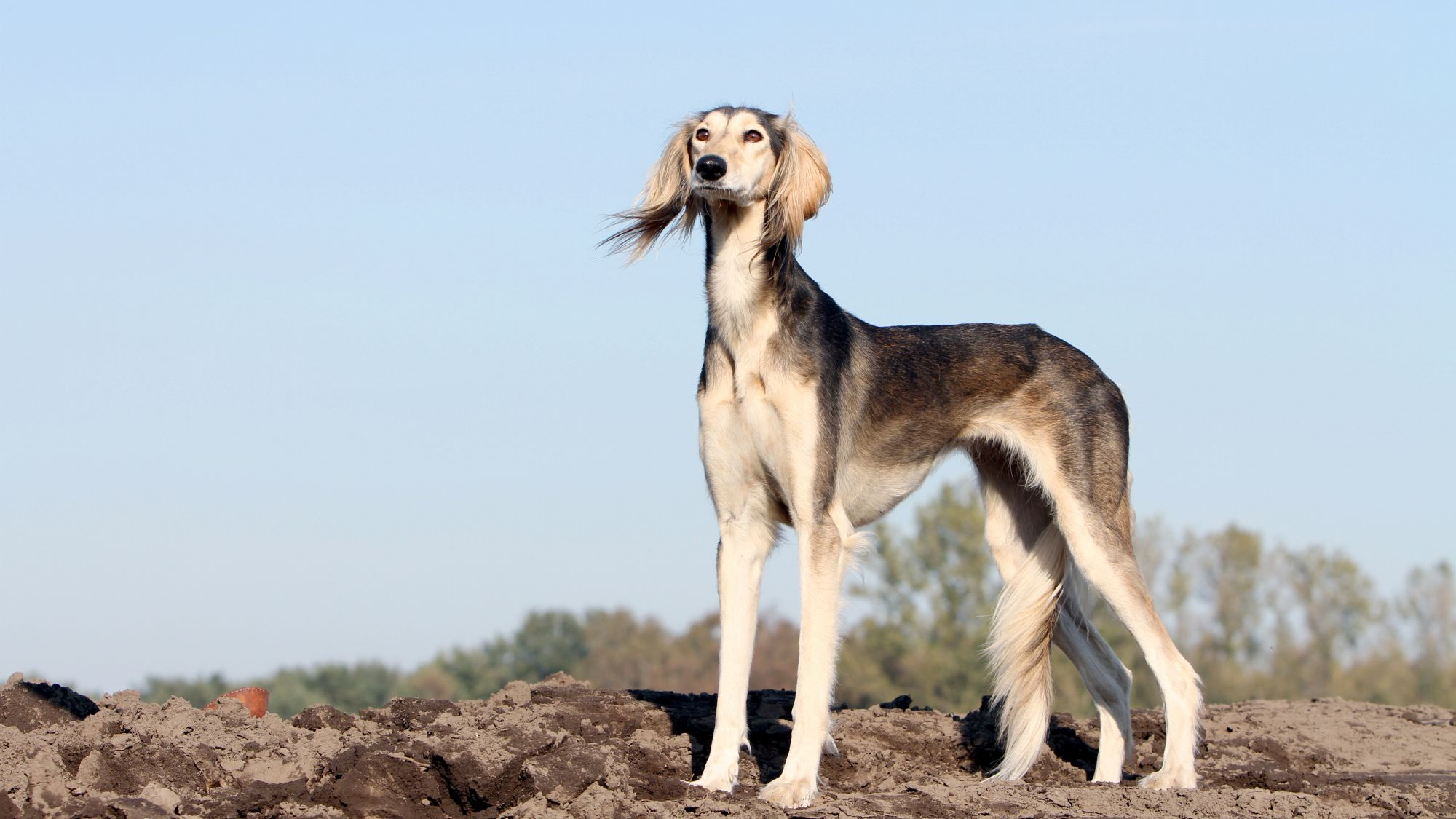
Get to know the Saluki
All you need to know about the breed
Elegant, graceful, noble, resplendent … the Saluki elicits a scramble for adjectives that can do justice to the breed’s particularly dignified brand of beauty. Fine features, wispy hair, you would be forgiven for assuming the breed frail with their lean bodies and delicate appearance. They are anything but.
One of the world’s most ancient breeds, Salukis are sighthounds, bred for centuries to track their quarry by sight rather than scent, a task at which they excelled. Though they make affectionate, loyal family pets once trained, Salukis still retain their incredible speed and stamina – they are thought to be the fastest breed on land over distance – ultra-attuned vision, and a high prey drive. Rabbit and hamster-owning families need not apply. And while we are at it, this isn’t the breed for anyone with a lazy lifestyle—while content to cocoon when home, Salukis need lots of daily exercise to be truly content and healthy.
The Saluki is a highly intelligent breed. That means they eventually take to training well. Highly strung and sensitive, they march to their own canine beat. As such, they are not ideal dogs for first time or inexperienced owners. However, Salukis are extremely patient and wonderful with children and, while not overly demonstrative, completely attached to their humans.
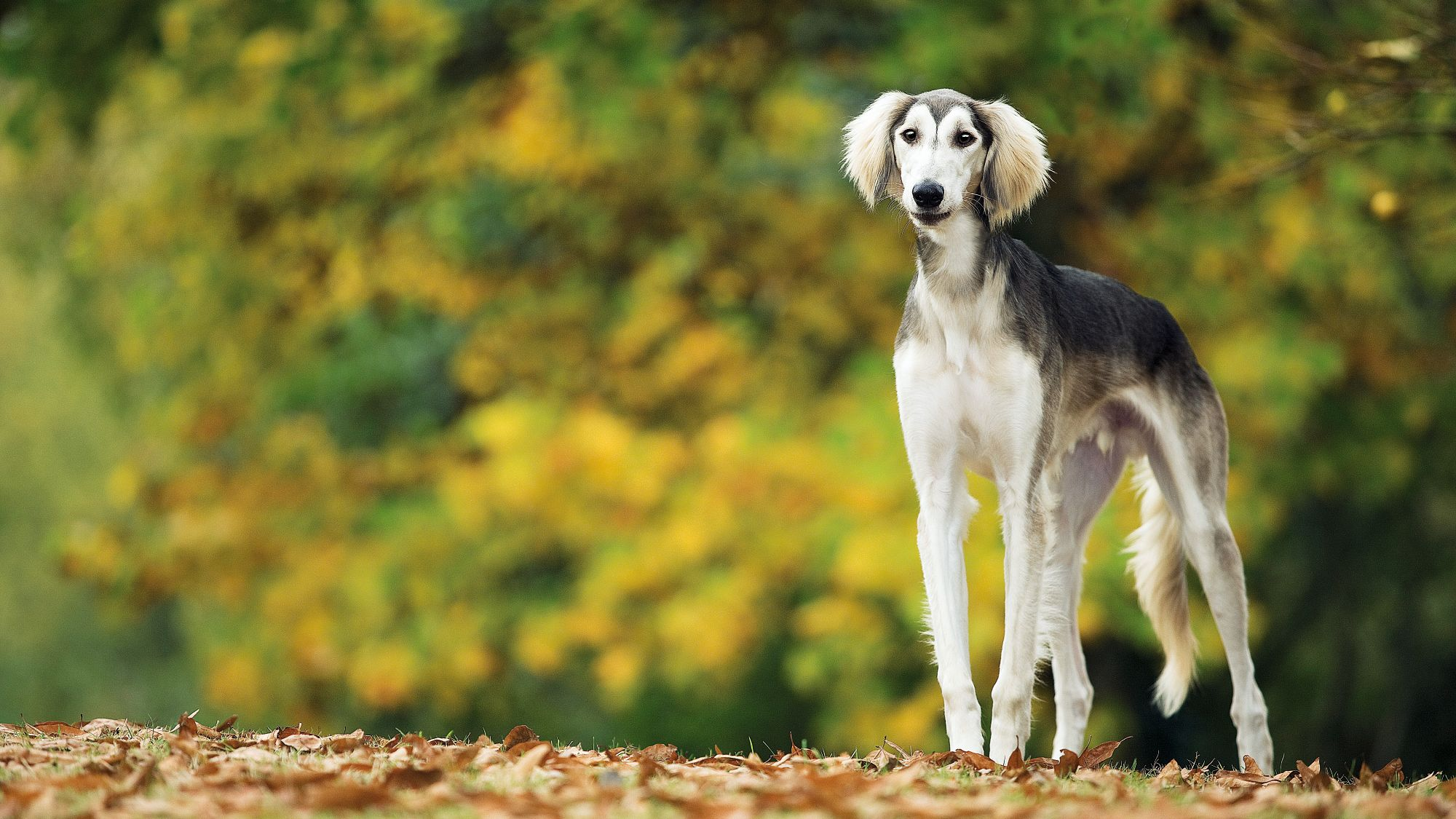
2 facts about Salukis
1. Walk like an Egyptian
With heritage tied to various lands in the Middle East, Salukis are sometimes called the royal dog of Egypt. Saluki remains have even been discovered in the upper Nile in tombs. Highly esteemed by Egyptian nobility who valued Salukis as true companions, the dogs were mummified when they died, honoured in the same manner as Pharaohs.
2. I see you
Salukis are sighthounds and as such, have quite simply extraordinary eyesight. Bred to hunt by sight and speed, they rely on their eyes rather than their noses to find their prey. That narrow face? Gives them a wild field of vision. And historically, because they run so fast, no humans could ever keep up so they worked alone a lot of the time while waiting—hence, their independent nature.
History of the breed
One of the oldest breeds in the world, archaeologists have identified Middle Eastern artifacts, pottery and Sumerian tomb illustrations depicting Saluki-like dogs dating back 5000 years or more. Originating in the Fertile Crescent – a region that spans modern-day Egypt, Jordan, Iraq, Syria, Palestine, Israel, Lebanon, the south-eastern part of Turkey and western fringes of Iran – the Saluki served as a desert hunter for nomadic tribes, agile and swift but also loyal and mild-mannered. The Bedouins still rely on the breed, respecting the breed’s clean habits to such an extent that the dogs are allowed inside their tents.
While the Saluki’s journey to Europe is harder to pin down, it is thought they were brought to the continent in the 12th century. They came to England around 1840, but it took the Hon. Florence Amherst importing a pair of Arabian Salukis from a royal kennel in Transjordania, in present-day Jordan, to her home in Norfolk in 1895 for the breed to take off. Their ranks grew after WW1 when British officers came back from the Middle East with Salukis in tow.
The AKC formally recognised the breed in 1927. Interestingly, the breed standard was established that year, taken from the 1923 British standard, and has stayed the same, the oldest unchanged sighthound standard in the American Kennel Club.
From head to tail
Physical characteristics of Salukis
1.Coat
2.Face
3.Body
4.Feet
5.Tail
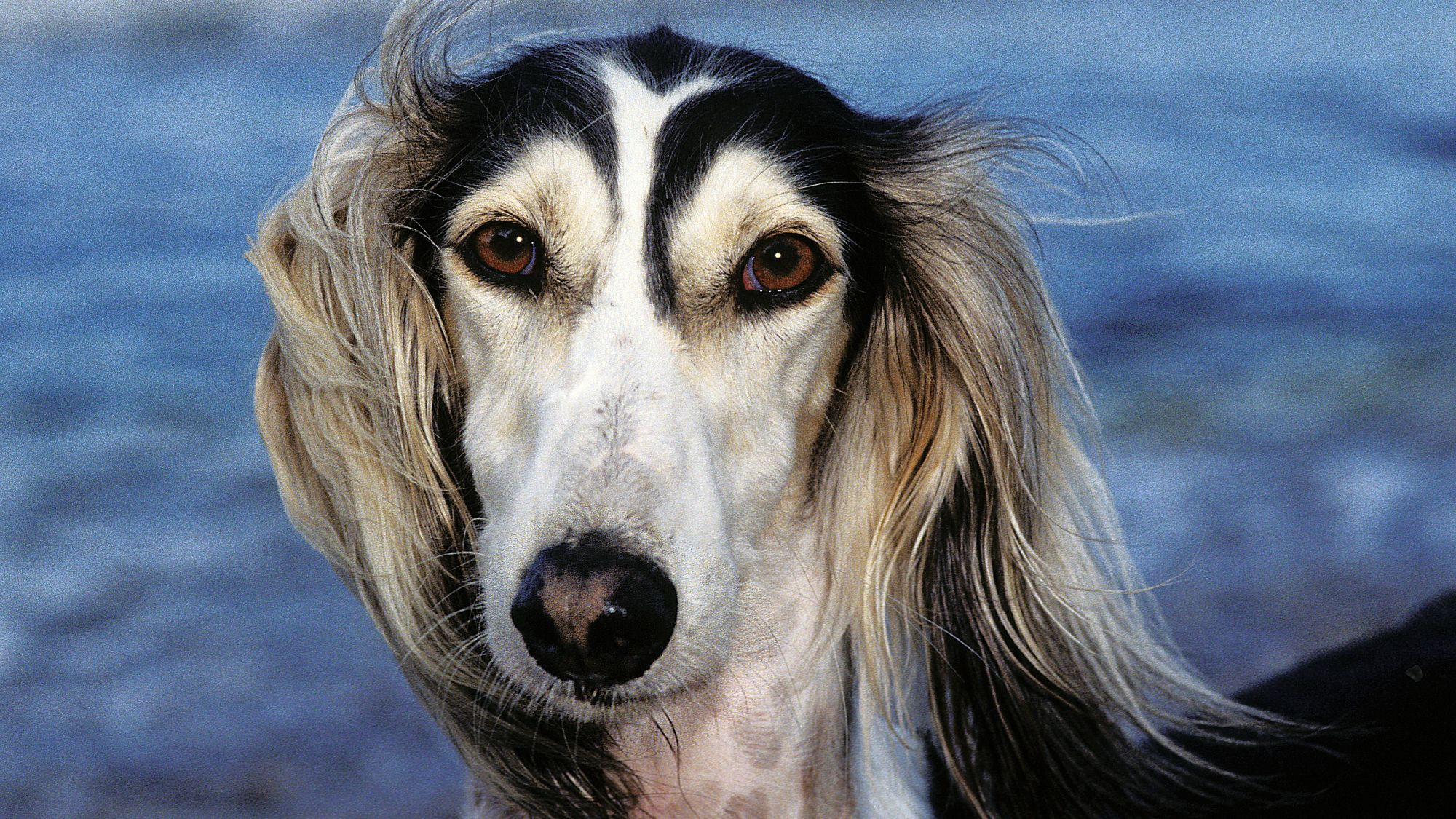
Things to look out for
From specific breed traits to a general health overview, here are some interesting facts about your Saluki
Pretty healthy overall
As a breed descended from hounds in various lands, the Saluki gene pool is pretty healthy. However, like many large breeds, bloat – gastric dilatation-volvulus (GDV), a sudden and extremely dangerous swelling of the dog’s abdomen – can be an issue. Get to know the symptoms as it requires immediate veterinarian attention: Bloated abdomen, restlessness, retching, salivation and whining or sudden stillness. Splitting meals into smaller ones and avoiding vigorous exercise around mealtimes is strongly suggested. Salukis can also be susceptible to certain cancers. Your vet can help spot any problems during regular visits.
Padding please
Tall, naturally thin and, frankly, quite bony even while muscular and mind-blowingly fast, Salukis don’t carry extra weight or fat so their bed needs to be well cushioned for the breed’s ultimate comfort. Think extra-soft blankets and other layers.
Healthy diet, healthier dog
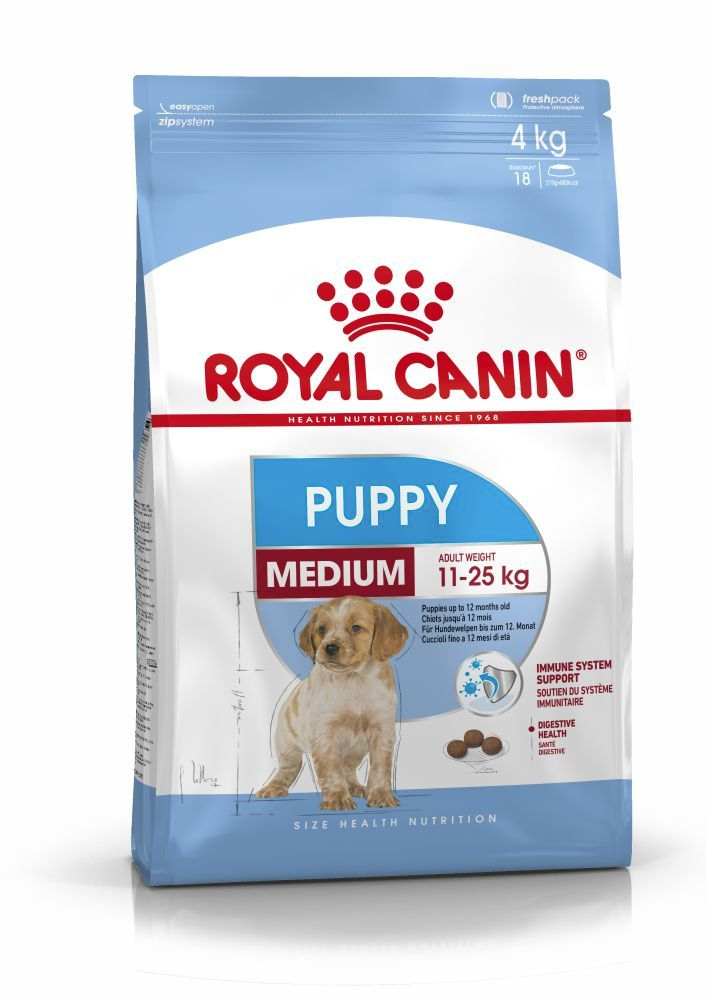
When choosing food for a Saluki, there are many factors to consider: Their age, lifestyle, activity level, physiological condition, and health including potential sickness or sensitivities. Food provides energy to cover a dog’s vital functions, and a complete nutritional formula should contain an adjusted balance of nutrients to avoid any deficiency or excess in their diet, both of which could have adverse effects on the dog.
Clean and fresh water should be available at all times to support good urinary regularity. In hot weather and especially when out exercising, bring water along for your dog’s frequent water breaks.
Energy intake may also have to be adapted to the climatic conditions. A dog that lives outdoors in winter will have increased energy requirements.
The following recommendations are for healthy animals. If your dog has health problems, please consult your veterinarian who will prescribe an exclusively veterinary diet.
A Saluki puppy’s requirements, in terms of energy, protein, minerals, and vitamins, are much greater than those of an adult dog. They need energy and nutrients to maintain their body, but also to grow and build it. Until they are 12 months old, a Saluki puppy’s immune system develops gradually. A complex of antioxidants – including vitamin E – can help support their natural defences during this time of big changes, discoveries, and new encounters. Their digestive functions are different from those of an adult Saluki, too: Their digestive system is not mature yet so it’s important to provide highly-digestible proteins that will be effectively used. Prebiotics, such as fructo-oligosaccharides, support digestive health by helping balance the intestinal flora, resulting in good stool quality.
Similarly, a puppy’s teeth – starting with the milk teeth, or first teeth, then the permanent teeth – are an important factor that needs to be taken into account when choosing the size, shape, and texture of kibble. This short growth phase also means high energy needs, so the food must have a high energy content (expressed in Kcal/100g of food), while concentrations of all other nutrients will also be higher than normal in a specially-formulated growth food. It is recommended to split the daily allowance into three meals until they are six months old, then to switch to two meals per day.
Throughout their life, it is important to avoid feeding Salukis human foods or fatty snacks. Instead, reward them with kibble taken from their daily meal allowance, and strictly follow the feeding guidelines written on the package in order to prevent excessive weight gain.
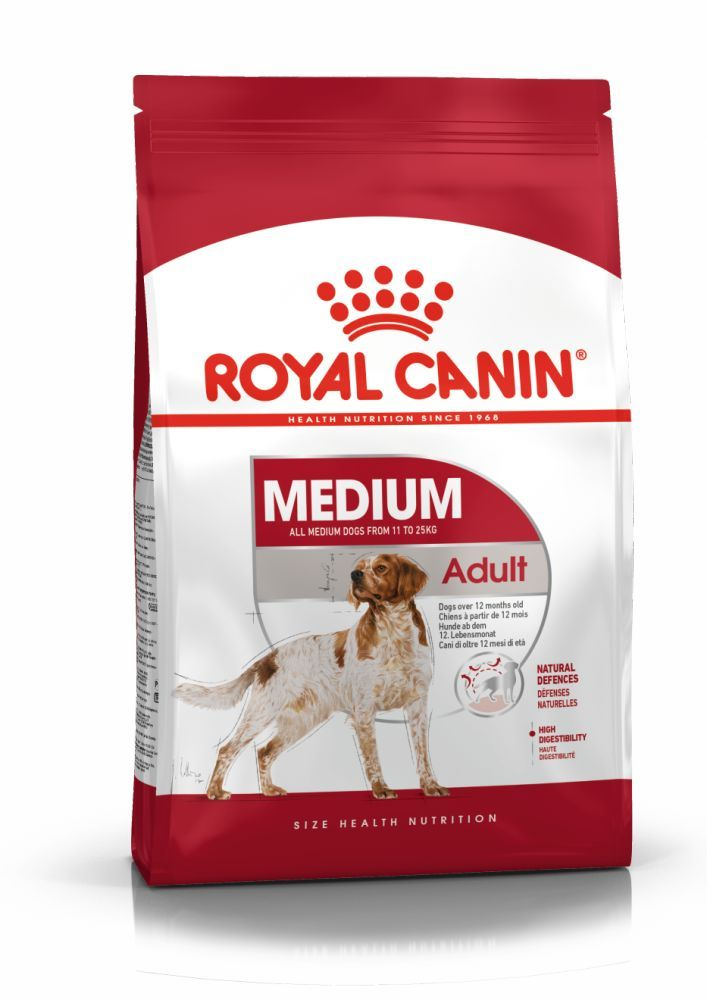
The main nutritional goals for adult Salukis are:
Maintaining an ideal body weight by using highly-digestible ingredients and keeping the fat content at a sensible level.
Promoting optimal digestibility with high-quality protein and a balanced supply of dietary fibre.
Helping to preserve the health and beauty of the skin and coat with the enriched addition of essential fatty acids (especially EPA and DHA), essential amino acids, and B vitamins.
To help support their natural defences, a formula enriched with an antioxidant complex and containing mannan-oligosaccharides is recommended.
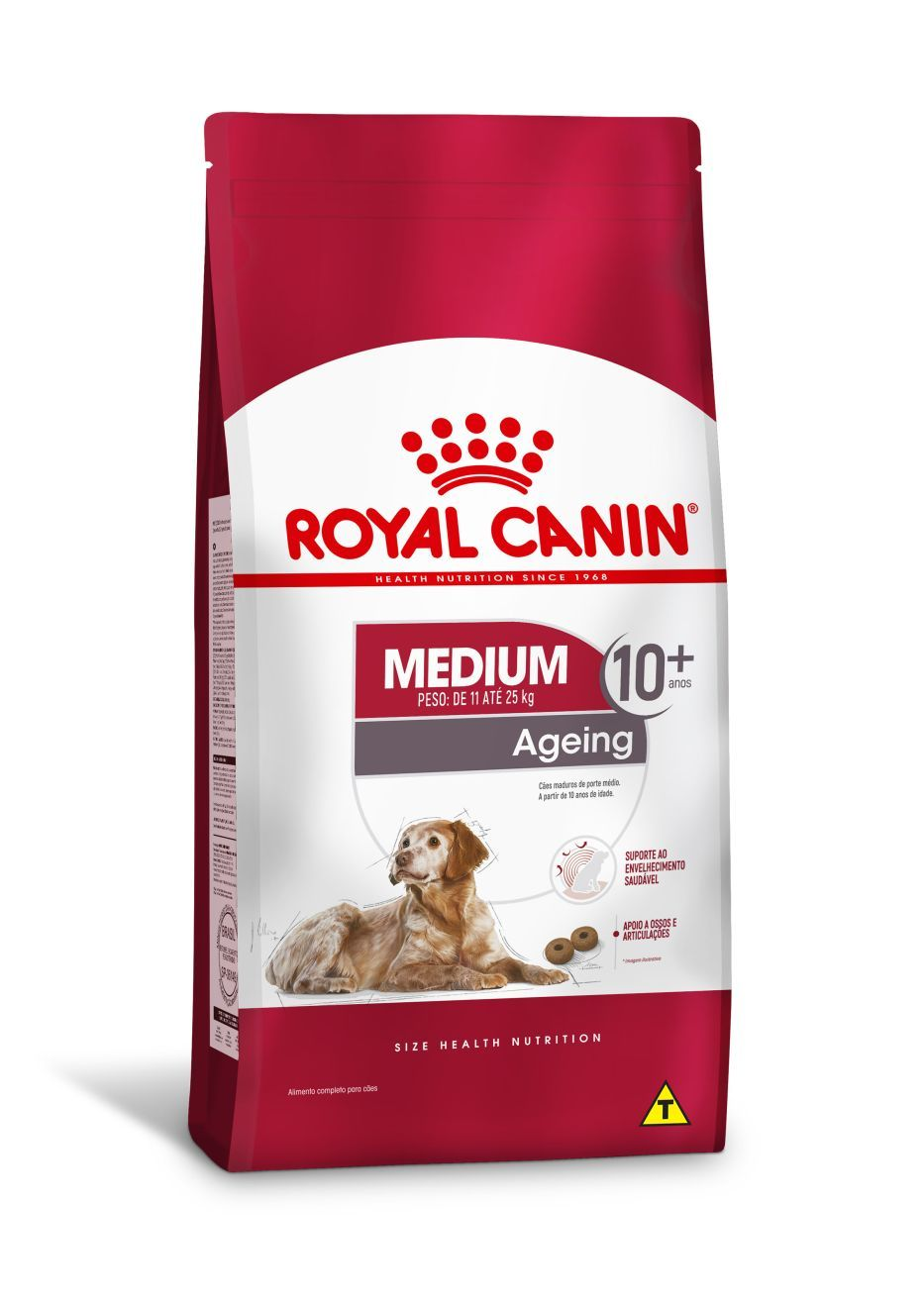
After 7 years old, Salukis start facing the first signs of ageing. A formula enriched with antioxidants will help maintain their vitality, and specific nutrients, such as chondroitin and glucosamine, will help maintain healthy bones and joints. Ageing is also accompanied by the modification of digestive capacities and particular nutritional requirements, so food for older Salukis should have the following characteristics:
Higher vitamin C and E content. These nutrients have antioxidant properties, helping to protect the body’s cells against the harmful effects of the oxidative stress linked to ageing.
High-quality protein. Contrary to a widely held misconception, lowering the protein content in food brings little benefit in limiting kidney failure. In addition, older dogs are less efficient at using dietary protein than younger dogs. Reducing the phosphorous content is a good way of slowing down the gradual deterioration of kidney function.
A higher proportion of the trace elements iron, copper, zinc, and manganese to help maintain the good condition of the skin and coat.
A higher quantity of polyunsaturated fatty acids to help maintain the quality of the coat. Dogs can normally produce these fatty acids, but ageing can affect this physiological process.
As they age, dogs increasingly suffer from teeth problems. To ensure they continue to eat in sufficient quantities, the shape, size and hardness of their kibble needs to be tailored to their jaw.
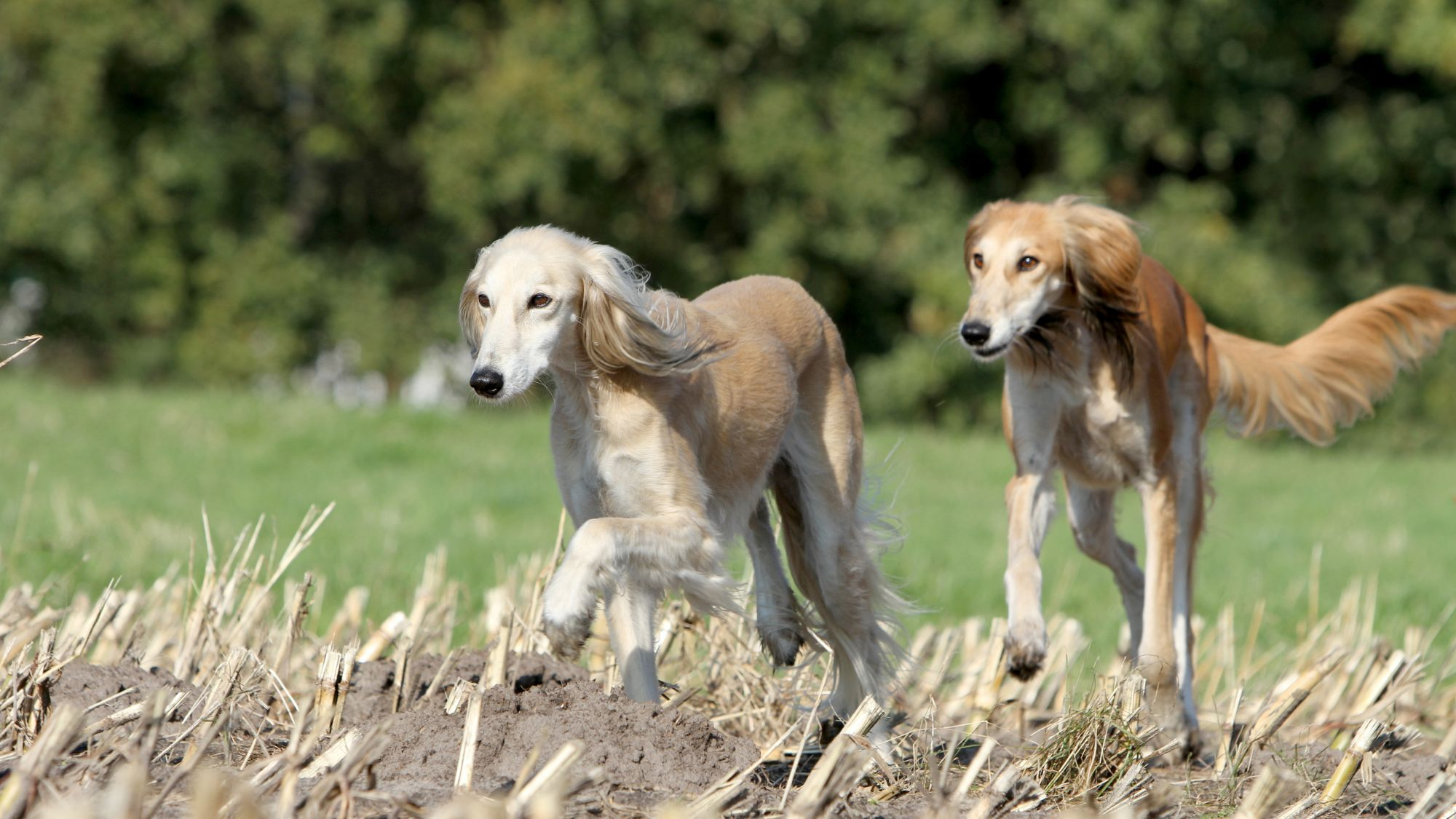
Caring for your Saluki
Grooming, training and exercise tips
Grooming the Saluki is quite straightforward. Their coats shed very little so a weekly brushing will suffice, with an extra brush through each week for the feathered parts.
Walks around the neighbourhood won’t satisfy this highly athletic breed: Salukis don’t just require twice daily exercise, they need to run a few times per week as well to truly thrive. Access to a large park or a really big fenced-in yard where they can let off steam is an ideal situation—however, the fence must be at least five feet high, six even. And no, those numbers are not a typo. Salukis are incredible jumpers and will easily scale anything lower. Bred to chase quarry, they still have a high prey drive and will chase most smaller animals so they must be kept on-lead when not in an enclosed area.
Training Salukis takes patience; this is not a breed for the inexperienced. Highly independent after centuries of working alone, such fast runners that humans can’t keep up, they will listen, just on their own timeline. One of the Saluki’s traits is to be highly sensitive, so kindness alongside that firm hand is key. Early socialisation will instil confidence around others.
7/7
All about Salukis
While your Saluki will be completely devoted to their human family, they tend to be a rather reserved breed by nature and keep their distance around strangers. Confrontation is not in their nature. So it might be you defending them.
As a sighthound, Salukis were bred to stalk in silence, a trait that means this is not an overly barky dog. In addition, reserved and wary around strangers, Salukis will tend to shy away from confrontation rather than bark to scare someone off. The neighbours will thank you.
Suggested Breeds
Read more on this topic
- Veterinary Centers of America https://vcahospitals.com/;
- Royal Canin Dog Encyclopaedia. Ed 2010 and 2020
- Banfield Pet Hospital https://www.banfield.com/
- Royal Canin BHN Product Book
- American Kennel Club https://www.akc.org/
Like & share this page